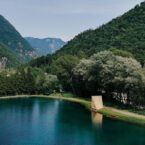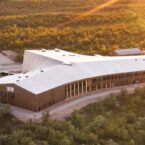
Like its namesake dragonfly, Casa Libélula floats gracefully over a river delta in Argentina, seamlessly blending into the vibrant ecosystem of the Delta Río Paraná. Designed by architects Barbara Berson and Horacio Sardin, this newly completed residence nestles within a willow forest, harmoniously merging traditional vernacular architecture with modern design. The timber home, raised on interlocking wooden stilts, evokes a sense of weightlessness while maintaining stability through meticulous craftsmanship. The architects have designed Casa Libélula with a minimalist aesthetic, reminiscent Continue reading “Like Its Namesake Dragonfly, Casa Libélula Floats Over a River Delta in Argentina” »

Escape’s latest innovation, the eONE XL, redefines the concept of spaciousness and light-filled living in the realm of micro-housing. Building on the success of its predecessors, the One and One XL models, the eONE XL introduces a rejuvenated design that emphasizes a more expansive and airy feel. This tiny home is mounted on a double-axle trailer and features a distinctive Japanese-style charred wood exterior, offering both aesthetic appeal and practical benefits like protection from decay and insects. Measuring 30 feet in length and 8.6 feet in width, the eONE XL maintains the dimensions of the One XL but surpasses it in terms of interior spaciousness and functionality. Large windows play a crucial role in the design, flooding the interior with natural light and creating a warm, inviting atmosphere. The all-electric appliances signify a modern, eco-friendly approach, further enhancing the micro-living experience.

Inside, the eONE XL tiny home boasts a well-thought-out layout that maximizes both storage and living space. The entrance opens into a well-equipped kitchen featuring a pantry storage area, fridge/freezer, microwave, induction cooktop, electric oven, sink, and ample cabinetry. Including a washer/dryer exemplifies the attention to detail in providing home-like conveniences within a compact space. Adjacent to the kitchen, the living room offers ample space, though it is pictured without furniture, suggesting customizable interior arrangements. Uniquely, the bathroom is well-appointed with a flushing toilet, sink with storage, and a rare addition in tiny homes: a shower and bathtub. The eONE XL also includes two upstairs bedrooms, accessible via a storage-integrated staircase. The master bedroom offers comfort and privacy, while the second bedroom, reached via a gangway, can double as a home office. With its innovative design and thoughtful amenities, the eONE XL sets a new standard in tiny home living, blending functionality with aesthetic charm and modern convenience.

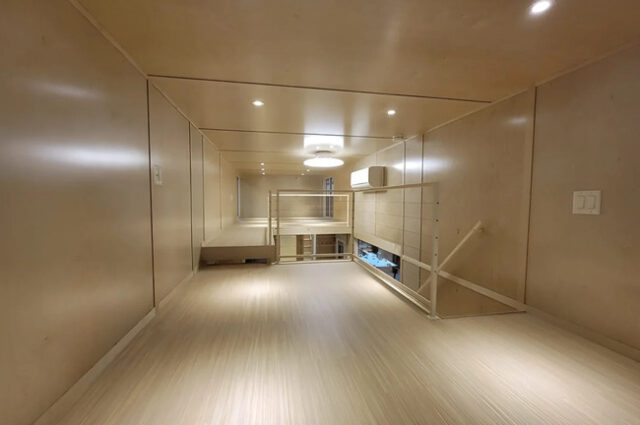



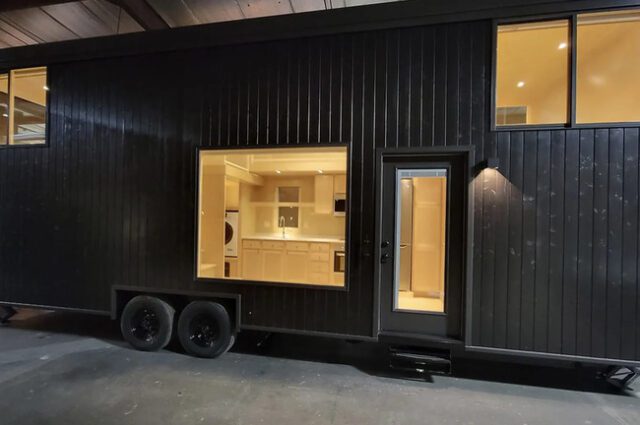

In an extraordinary event, Dan Charlton of Wakefield, West Yorkshire, witnessed a green light streak across the sky, followed by a soft “whoosh” sound, as a suspected meteorite plummeted near his home. The sighting occurred in the early hours, with Charlton initially mistaking the vibrant display for a firework. Upon closer observation, the object appeared to burn with a green flame before silently extinguishing. The next day, Charlton discovered a warm, charred rock on a nearby street, which he suspected to be the meteorite. The rock emitted a burnt smell, prompting Charlton to speculate its origin. Research led him to believe it might be debris from Halley’s Comet, adding to the mystique of the encounter.

Eager to validate his find, Charlton consulted a geologist and a professor at the University of Leeds. Initial tests, including a magnet check indicating a light magnetic field, supported the meteorite theory. However, Professor Simon Kelley, an expert in planetary science, expressed skepticism. Upon microscopic examination, Kelley noted the absence of a fusion crust, typical of meteorites, and identified features resembling terrestrial volcanic rocks. Despite this, he acknowledged that some meteorites do not conform to standard characteristics. Kelley planned further detailed analysis to determine the rock’s origin, including slicing and examining the rock’s internal structure. This process would take weeks, after which definitive results would be shared with Charlton, potentially solving the mystery of the warm, burnt rock.

When most people think of school science fairs, images of baking soda volcanoes and egg drops may fill their minds. However, for the most driven STEM students, the Regeneron International Science and Engineering Fair (ISEF) provides a far greater opportunity to showcase their inventions and research, as well as compete for significant amounts of money to further finance their projects. Grace Sun, a 16-year-old from Lexington, Kentucky, Continue reading “16-Year-Old Wins Highest Prize of $75,000 in Prestigious Science Fair for Her Work on Biomedical Implants” »

In the Northern Hemisphere, June ushers in longer days and warmer nights, accompanied by an exciting prospect for aurora enthusiasts. Following an extraordinary display of the Northern Lights in May, fueled by a massive sunspot labeled AR3664, the likelihood of witnessing another awe-inspiring aurora show in the coming weeks is high. AR3664, which is more than 15 times wider than Earth, was responsible for at least five significant solar storms. These storms sent charged particles crashing into Earth’s magnetosphere, resulting in spectacular light displays that were visible at unusually low latitudes. As these solar storms persist, Earth is expected to encounter more such phenomena, offering another opportunity to marvel at these beautiful lights.

What enhanced the visibility of even faint auroras in May was the absence of moonlight, thanks to the new moon, which minimized light interference similar to the effects of light pollution. This favorable condition is set to repeat with the next new moon on June 6, coinciding with the reappearance of AR3664 due to the Sun’s 27-day rotation. As the sunspot approaches the Sun’s center from our perspective, the chances of Earth being hit by solar storms increase, potentially leading to another round of vivid auroras. Solar physicist Ryan French from the National Solar Observatory highlights that this period presents a prime opportunity for aurora viewing. Moreover, with the 11-year solar cycle nearing its peak by summer 2025, more frequent and widespread sightings of the Northern Lights are anticipated, ensuring that this may not be the final opportunity to enjoy these natural light shows below the Arctic Circle. For the best viewing experience, enthusiasts should keep an eye out between 10 p.m. and 2 a.m. local time.



In a groundbreaking archaeological discovery in Carlisle, England, a team unearthed a rare sample of Tyrian Purple, a pigment once more valuable than gold. This discovery found preserved in the drains of a third-century Roman bathhouse, sheds light on the opulent lifestyle and intricate trade networks of ancient Rome. Continue reading “Archeologists Unearth a Rare Purple Pigment That Is More Valuable Than Gold ?” »
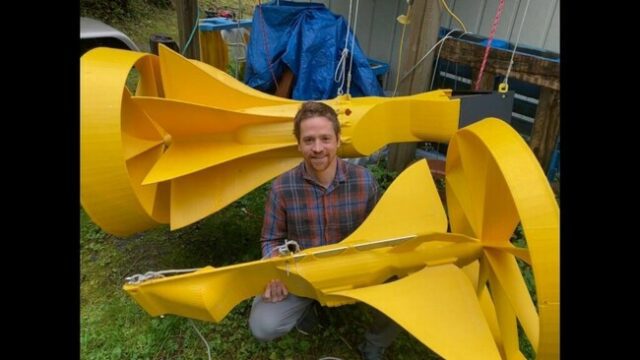
Lance McMullan, an inventive mind from Juneau, Alaska, has developed a groundbreaking solution to harness tidal power for small vessels and houseboats, offering a green alternative to traditional power sources. His creation, a 3D-printed tidal power generator, is designed to deliver 1.6 kilowatts of power simply by being dropped into the water like an anchor. McMullan’s startup, Sitkana, which secured $90,000 in seed funding last year, Continue reading “Alaskan Inventor is 3D Printing Tidal Power Generators for Houseboats: Just Drop Anchor and Power On” »
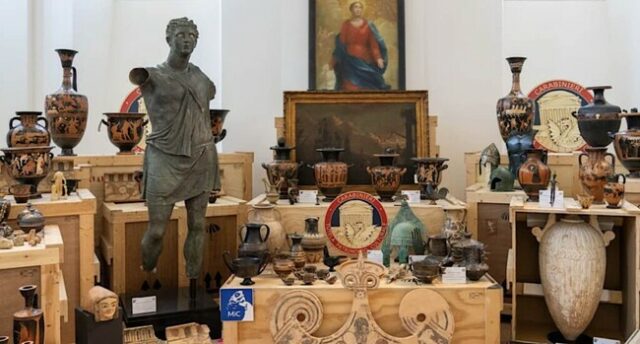
The United States recently returned a significant collection of 600 ancient artifacts, valued at approximately €80 million, to Italy, reaffirming the importance of preserving cultural heritage. These artifacts, which range from the 9th century BCE to the 4th century CE, include Roman coins, a mosaic floor, Umbrian bronzes, military equipment, oil paintings, sculptures, and various pottery pieces. They were illicitly excavated or stolen from regions such as Calabria, Campagna, Puglia, Sicily, and Lazio. The Art Trafficking Unit (ATU) of the Manhattan District Attorney’s Office, led by Prosecutor Matthew Bogdanos, played a crucial role in their recovery, often seizing items from private collections and convincing museums to return pieces based on compelling evidence of their illicit origins.

Collaboration between the ATU and Italy’s Carabinieri for the Protection of Cultural Heritage, who utilize the Stolen Works Of Art Detection System (SWOADS), was instrumental in this operation. General Francesco Gargaro highlighted that stolen artifacts lose not only their physical presence but also their historical context, which is vital for archaeological research. The collection includes notable relics like a well-preserved Umbrian bronze statue, 2,400-year-old bronze heads, and a mosaic floor depicting Orpheus. Bogdanos emphasized that while local looting may be difficult to prevent, controlling the trade of these artifacts in the West can mitigate such losses. Under the leadership of District Attorney Alvin Bragg, the ATU has recovered and returned over 1,000 antiquities from 27 countries, highlighting Manhattan’s pivotal role in combating art trafficking and repatriating stolen heritage.

The DIY Game Boy Arcade project reinvents the classic handheld gaming experience by blowing up its size and embedding it into a large arcade cabinet. This unique twist transforms the Game Boy’s iconic green-tinted monochrome display into a giant screen, providing a more immersive gaming experience. The arcade setup is not just about visual expansion; it also includes giant controls, replacing the original handheld’s Continue reading “DIY Game Boy Arcade Blows Up Classic Titles with a Giant Screen and Giant Controls” »




































